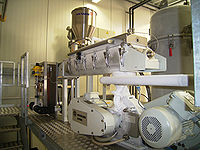Cryogenic Grinders
Cryogenic Grinders are used for application of cryogenic grinding that allows composite materials such as fibre-reinforced thermoplastics, tin cans with product remains such as paint and lacquer adherences, galvanised plastic parts (e.g. sanitary facilities) or old tyres to be separated into their pure components. The success of the process is due to the different linear extension coefficients and embritteling abilities of the materials.
Process
For pulverizing many materials, cryogenic grinding technology increases productivity and lowers power costs. Many elastic or "soft" materials are very difficult to pulverize, requiring long cycle times and high energy consumption. This combination decreased productivity and increased costs unnecessarily. Cryogenic grinding involves cooling a material below its embrittlement temperature with a cryogenic fluid, typically liquid nitrogen or, in certain applications, carbon dioxide. After cooling, the material is fed into an impact mill where it is reduced in size primarily by brittle fracture.
Probably the greatest benefit provided by cryogenic grinding is the ability to grind "soft" or elastic materials that otherwise could not be ground, or could be ground only with long cycle times and high energy use. By embrittling the material, fine powder or crumb can be obtained easily and with a minimum expenditure of energy. Because embrittled material grinds easily, the throughput for a given mill is substantially increased and less power is used per pound of material ground.
Cryogenic grinding also reduces the material to particle sizes difficult or impossible to attain with ambient temperature grinding. The dry, cold, inert atmosphere in which the grinding occurs minimizes reaction with the material and reduces the loss of volatile components. When processing composite materials, cryogenic grinding usually makes it easy to separate the various materials.
Advantages
- Higher process volumes
- Higher volumes of a finer product
- Lower energy consumption
- No melting or sticking of temperature sensitive plastics
- Set grinding temperatures prevent heat damage
- No loss of aromatic materials during the grinding of spices
- Greater protection against dust explosion
Applications
Cryogenic grinding is used for grinding spices, thermoplastics, elastomers, color concentrates, and similar materials. It is also used to recover a variety of scrap materials, such as factory scrap rubber and scrap tires, and to separate the components in composite materials.
Video
